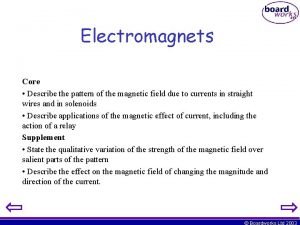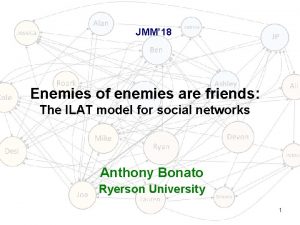Week 4 Enemies make you stronger allies make





























- Slides: 29

Week 4 Enemies make you stronger, allies make you weaker. Frank Herbert

Full Adder

1 Bit ALU OR and AND functions are implemented separately AND gates control which functional unit will have output Adder is used to Add, Sub, Invert Inversion is controlled by the XOR Decoder determines what the ALU will do. Outputs of the decoder will activate AND gates and control the inputs (inversion) as appropriate

4 Bit ALU These sensors input define the 4 bit A and B inputs to the ALU Replicate the 1 Bit ALU 4 times Sensor is used to select the ALU function Subtraction is ALU function 2, must force 2’s complement by adding 1 to the inverse of the A input, force Cin to 1.

SR Latch

D-Latch

D-Latch with enable

1 x 4 Memory Circuit

2 -4 Decoder

MIPs Architecture

Introduction To MIPs Architecture • Register file is central. • All operations will involve the registers.

Another View of the R 2000

MIPS Register File

MIPs Instruction Format

Register Format

Register Format Example

Immediate Format

Immediate Format Example

IR contains some example instruction Based on the format, Rs, Rt and Rd will always reference the register file. There values enter the ALU results go back to register file, these in turn can be loaded or stored to main memory. Immediate values directly enter the ALU.

Addressing Modes • Defines how information is moved • To memory • From memory • Through the ALU • Each type of CPU will have a defined set of valid modes. • MIPS - 5 addressing modes • X 86 – 12 addressing modes • The modes are realized in the instruction set architecture • Define the assembly syntax. • Modes are responsible how address resolution of each instruction is accomplished.

Effective Address • The result of a assembly instruction decode is an operator (opcode) and operand resolution. • Operand resolution often calculates the effective address of the operand • Memory location • Register • E. g. • • Add $t 0, $t 1, $t 2 – each operand resolves to a register in the register file LW $t 0, ($t 2) -- ($t 2) resolves to a memory location SW $t 0, 4($t 2) -- resolves to a memory location ($t 2) + 4. LW $t 0, label -- label defines a memory address

Register Addressing • Instruction will only use registers from the register file. • E. g. add $t 0, $t 1, $t 2 • Can be read as the contents of $t 1 + $t 2 is stored in $t 0. • View registers in the register file as variables which can be directly accessed.

Base Displacement • Contents of a register is an address in memory. • Defined when a register is in brackets • E. g. lw, $t 0, ($t 1), where register t 1 contains a memory address. • Offsets from this address are defined as: • Lw $t 0, 4($t 1) • Read as 1 word displaced from base address ($t 1). • Usage: Record processing, where base of record is stored in the register, variables are offsets from the base. • Note: 1 word is 4 bytes, so each word has a 4 byte offset.

Immediate Addressing • Directly load a register with a defined value or literal • E. g. li $t 0, 0 -- puts the value 0 into register $t 0.

PC Relative • Effective address is calculated relative to the PC. • E. g. b label -- Branch unconditionally • Effective address is calculated as: • PC + Offset where offset is signed allowing forward and backward branching

Pseudo PC Direct • Effective address is a direct memory address: • E. g. J target where target is an absolute memory address • Usage jumping to a procedure • Jumping to another process.

MIPs Addressing Modes

Pseudo vs True Assembly Instructions • For convenience MIPs has a large set of Pseudo instructions, also called macro instructions. • Assembler will expand these to true Assembly (instruction set architecture instructions). • Makes coding easier. • E. g. Load address • la $t 0, some_variable • will load the memory address of some_variable into $t 0. • This is expanded to: • lui $1, memory_address of some_variable ori $t 0, $1, 0

The End
 Shrek ordinary world
Shrek ordinary world The more you care the stronger you can be
The more you care the stronger you can be Three ways to make an electromagnet stronger
Three ways to make an electromagnet stronger You were enemies of god
You were enemies of god Conditional sentences wish
Conditional sentences wish Week by week plans for documenting children's development
Week by week plans for documenting children's development Romans 1:24
Romans 1:24 Cindy mele
Cindy mele Enemies of good credit
Enemies of good credit John piper love your enemies
John piper love your enemies Batman enemies
Batman enemies Assyrian archers pursuing enemies
Assyrian archers pursuing enemies Characteristics of enemies of the cross
Characteristics of enemies of the cross Humayun was surrounded by enemies. elaborate.
Humayun was surrounded by enemies. elaborate. Rebellious subjects enemies to peace
Rebellious subjects enemies to peace Reverend parris characterization
Reverend parris characterization Rest from your enemies
Rest from your enemies I sing a hallelujah in the presence of my enemies
I sing a hallelujah in the presence of my enemies Enemies of god ephesians
Enemies of god ephesians Vampire bat enemies
Vampire bat enemies Lesson 4 the allies turn the tide
Lesson 4 the allies turn the tide Stele
Stele Note three ways war affected the land and people of europe.
Note three ways war affected the land and people of europe. Childe hassam allies day may 1917
Childe hassam allies day may 1917 Chapter 16 section 4 the allied victory
Chapter 16 section 4 the allied victory Ares personality
Ares personality Mania in ww1
Mania in ww1 Turn the tide chapter 1
Turn the tide chapter 1 Guided reading wilson fights for peace
Guided reading wilson fights for peace World war 1 allies
World war 1 allies




















































